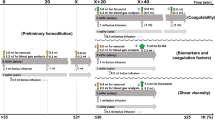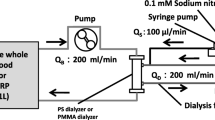Abstract
Nonionic contrast media (NICM) used in radiology exhibit weaker anticoagulant properties than ionic media. This study was intended to evaluate the effect of iopromide NICM upon the platelet aggregation and their membrane structure (investigated by electron paramagnetic resonance method with a spin label). Blood was collected directly from the left ventricle during coronary angiography prior to and following the application of the contrast medium. These results were compared with in vitro examinations. Based on the spectral curves parameters that reflect conformational changes in membrane proteins were determined. The iopromide-induced decrease in platelet aggregation examined in vitro with adenosine diphosphate (ADP), collagen and ristocetine was statistically significant. In vitro platelet membrane structure was modified significantly with regard to both protein conformation and the accessibility of sulfhydryl (- SH) and amino (- NH2) groups. In ex vivo studies the changes in platelet aggregation was only observed with ADP, whereas in the membrane-structure modifications were only noted regarding accessibility of - SH and - NH2 groups. We conclude that iopromide-induced platelet aggregation changes are most probably due to their membrane-structure modifications, whereas the less-pronounced contrast effect ex vivo is due to its rapid dilution in the inflowing blood. The results confirm weak antiplatelet and anticoagulant influence of NICM in vivo.
Similar content being viewed by others
References
Davidson CJ, Mark DB, Pieper KS, Kisslo KB, Hlatky MA, Gabriel DA (1990) Thrombotic and cardiovascular complications related to nonionic contrast media during cardiac catheterization; analysis of 8517 patients. Am J Cardiol 65: 1481–1484
Fareed J, Walenga JM, Saravia GE, Moncada RM (1990) Thrombogenic potential of nonionic contrast media. Radiology 174: 321–325
Grabowski EF (1990) A Hematologist's view of contrast media, clotting in angiography syringes and thrombosis during coronary angiography. Am J Cardiol 66: 23F-25F
Stormorken H, Skalpe IO, Testar MC (1986) Effect of various contrast media on coagulation, fibrinolysis, and platelet function. An in vitro and in vivo study. Invest Radiol 21: 348–354
Esplugas E, Cequier A, Jara F et al. (1991) Risk of thrombosis during coronary angioplasty with low osmolality contrast media. Am J Cardiol 68: 1020–1024
Dawson P, Hewitt P, Mackie IJ, Machin SJ, Amin S, Bradshaw A (1986) Contrast, coagulation, and fibrinolysis. Invest Radiol 21: 248–252
Parrez Z, Moncada R (1986) Nonionic contrast medium: effects on blood coagulation and complement activation in vitro. Angiology 37: 358–364
Stormorken H (1988) Effects of contrast media on the hemostatic and thrombotic mechanisms. Invest Radiol 23 (Suppl 2): S318-S325
Corot C, Perrin JM, Belleville J, Amiel M, Elroy R (1989) Effect of iodinated contrast media on blood clotting. Invest Radiol 24: 390–393
Ing JJ, Smith DC, Bull BS (1989) Differing mechanisms of clotting inhibition by ionic and nonionic contrast agents. Radiology 172: 345–348
Taylor MA, Angello DA, Ayers CR, Gear AR (1991) Radiographic contrast agents and platelet function: a quenched-flow study. Cathet Cardiovasc Diagn 22: 295–301
Levi M, Pascucci C, Agnelli G, Sturk A, Hoek J, Wouter ten Cate J (1990) Effect on thrombus growth and thrombolysis of two types of osmolar contrast media in rabbits. Invest Radiol 25: 533–535
Shah PK, Forrester JS (1991) Pathophysiology of acute coronary syndromes. Am J Cardiol 68: 16C-23C
Almen I, Nyman V (1980) Effects of contrast media on aortic endothelium. Experiments in the rat with non-ionic and ionic monomeric and monoacidic dimeric contrast media. Acta Radiol 362 (Suppl) 65–71
Grabowski EF (1989) Effects of contrast media on endothelial cell monolayers under controlled flow conditions. Am J Cardiol 64: 10E-15E
Riemann CD, Massey CV, McCarron DL, Borkowski P, Johnson PC, Ziskind AA (1993) Ionic contrast agent-mediated-endothelial injury causes increased platelet deposition to vascular surfaces. Am Heart J 125: 71–78
Granger CB, Gabriel DA, Reece NS et al. (1992) Fibrin modification by ionic and nonionic contrast media during cardiac catheterization. Am J Cardiol 69: 821–823
Backer RC, Clyne C, Weiner BH et al. (1991) Heparin pharmacokinetics and in vitro anticoagulant activity in patients receiving nonionic radiographic contrast media. Cardiology 79: 31–38
Gloth ST, Gerstenblith G, Brinker JA (1992) Contractile, metabolic and arrhythmogenic effects of ionic and nonionic contrast agents in the isolated rat heart. Am Heart J 124: 651–656
Wisneski JA, Gertz EW, Dahlgren M, Muslin A (1989) Comparison of low osmolality ionic (ioxag late) versus nonionic (iopamidol) contrast media in cardiac angiography. Am J Cardiol 63: 489–495
Weiss HJ (1986) Platelet aggregation. In: Williams WJ, Beutler E, Ersler AJ, Lichtman MA (eds) Hematology. McGraw-Hill, Singapore, pp 1673–1675
Saeverheber RD, Zimmerman TS, Esgate JA, Vanderlaan WP, Gordon LM (1980) Effects of calcium, lanthanum and temperature on the fluidity of spin-labeled human platelets. J Membr Biol 52: 201–219
Steiner M (1981) Vitamin E changes the membrane fluidity of human platelets. Biochim Biophys Acta 640: 100–105
Nurden AT, George JN, Phillips DR (1986) Platelet membrane glycoproteins: their structure, function and modification in disease. In: Phillips DR, Shurman MA (eds) Biochemistry of platelets. Academic Press, London, pp 159–224
Górski J, Nowak J, Slox A, Winnicka A (1992) Nitroglycerin modifies blood platelets membrane structure. Ann Hematol 64 (Suppl): 31 abstract
Loscalzo J (1992) Antiplatelet and antithrombotic effects of organic nitrates. Am J Cardiol 70: 188–228
Author information
Authors and Affiliations
Additional information
Correspondence to: J. Górski
Rights and permissions
About this article
Cite this article
Górski, J., Flasiński, J., Slonecka, A. et al. Effect of a low-osmolality nonionic contrast medium (iopromide) on blood platelet membrane structure and aggregation. Eur. Radiol. 5, 543–546 (1995). https://doi.org/10.1007/BF00208350
Received:
Revised:
Accepted:
Issue Date:
DOI: https://doi.org/10.1007/BF00208350




